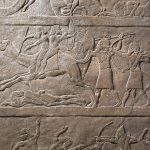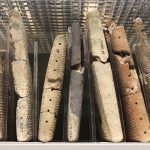The Missing linkk?
Joshua J. Mark wrote:
The Myth of Adapa (also known as Adapa and the Food of Life) is the Mesopotamian story of the Fall of Man in that it explains why human beings are mortal. The god of wisdom, Ea, creates the first man, Adapa, and endows him with great intelligence and wisdom but not with immortality, and when immortality is offered Adapa by the great god Anu, Ea tricks Adapa into refusing the gift.
Though it is not expressed directly in the myth, Ea’s reasoning in this seems similar to Yahweh’s in the Genesis story from the Bible where, after Adam and Eve are cursed for eating of the Tree of the Knowledge of Good and Evil, Yahweh casts them out before they can also eat of the Tree of Life:
“Behold, the man is become as one of us, to know good and evil; and now, lest he put forth his hand and take also of the tree of life, and eat, and live forever; Therefore the Lord God sent him forth from the garden of Eden”(Genesis 3:22-23)
If Adam and Eve were immortal they would be on par with Yahweh and there would be a loss of status for the god; and this is Ea’s same reasoning in the Adapa myth. In the Genesis myth, man takes knowledge for himself by eating of the tree; in the Mesopotamian myth, the god Ea grants man knowledge in the process of creation. Knowing that Adapa is already wise, Ea (like Yahweh in the later story from Genesis) needs to keep the man in his place.
Adapa was the king of the city of Eridu and, the myth tells us, went fishing one day in the Persian Gulf when the south wind suddenly capsized his boat and hurled him into the sea. Furious at this, Adapa broke the wing of the south wind and for seven days the wind could not blow. The sky god Anu is angered by this and sends for Adapa to explain himself. Adapa receives counsel from Ea on how he should behave in the court of the gods. As Ea is Adapa’s father-god and creator, Adapa trusts him to tell him the truth. But Ea fears that Anu is apt to offer Adapa the food and drink of eternal life and Ea is intent on making sure that Adapa does not accept the offer.
First Ea tells him that he should flatter the guardians of the gates, Tammuz and Gishida (two dying and reviving deities) by making it known that he remembers them, that he knows who they are. If Adapa does this then the guardians will let him pass without difficulty and will speak favorably of him to Anu. Once Adapa is in the presence of Anu, Ea further tells him, he should refuse any food or drink offered because it will be the food of death and the drink of death which will be offered as punishment for Adapa breaking the wing of the south wind. However, Ea says, Adapa may accept oil to anoint himself and accept whatever clothing is offered.
Remaining part of the article is here:
http://www.ancient.eu/article/216/
2- ARE ADAPA AND ADAM ONE AND THE SAME?
ADAPA AND THE FOOD OF LIFE
[from “Cuneiform Parallels to the Old Testament ” by R.W. Rogers, 1912].
[Summary: Adapa, or perhaps Adamu, son of Ea, had recieved from his father, the god Ea, wisdom, but not eternal life. He was a semi-divine being and was the wise man and priest of the temple of Ea at Eridu, which he provided with the ritual bread and water. In the exercise of this duty he carried on fishing upon the Persian Gulf. When Adapa was fishing one day on a smooth sea, the south wind rose suddenly and overturned his boat, so that the was thrown into the sea. Angered by the mishap, he broke the wings of the south wind so that for seven days it could not blow the sea’s coolness over the hot land. Anu calls Adapa to account for this misdeed, and his father Ea warns him as to what should befall him. He tells him how to fool Tammuz and Gishzida, who will meet him at the gate of heaven. Ea cautions him not to eat or drink anything in heaven, as Ea fears that the food and drink of death will be set before Adapa. However, the food and drink of eternal life are set before him instead, and Adapa’s over-caution deprives him of immortality. He has to return to Earth instead.]
The text of the three tablets is here:
http://www.sacred-texts.com/ane/adapa.htm
3- NIELS-ERIK ANDREASEN WROTE:
The name Adapa has a tantalizing similarity to that of
Adam, a fact that has led to the suggestion that a simple phonetic
development may explain their relationship, i.e., a labial shift from
m to p, rather than vice versa. Moreover, the final ending a in
Adapa also appears in the Hebrew ‘adama, meaning “ground”/
“soil.” Finally, a-da-ap is reported by E. Ebeling to occur
in a syllabary text with the meaning “man.” Whatever
the merit of these linguistic considerations, the etymology of Adam
is itself uncertain. Is it “soil”/”ground,” (‘adama) or “red” (‘edom ),
or “blood” (dam)? As for the name Adapa, it appears frequently
with the epithet “the learned, the wise,” and is in fact now
known to be the name of the first of the seven antediluvian sages
(apkallu),11 each of whom is associated with an antediluvian king.12
Adapa is identified as the one who ascended to heaven, following
the account of our myth in a text published by E. Reiner,13 who on
the basis of the epithets apkallu and especially ummanu has concluded that Adapa is to be identified as a “master craftsman” with reference to the scribal arts, hence a vizier.
11 Apkallu, “wise man, expert, sage,” refers to the seven antediluvian sages and is an epithet of Adapa. CAD, A/11, 171-172. *4- IN THE ENTRY OF OANNES IN GERMAN WIKIPEDIA:*
Oannes ist nach Berossos die babylonische Bezeichnung eines Mischwesens aus Fisch und Mensch.
Außer einem Fischkopf soll Oannes ein Menschenhaupt, zusätzlich zu einem Fisch-Schwanz menschliche Füße und eine menschliche Stimme gehabt haben. Oannes gilt als Kulturbringer. Er entstieg morgens dem Meer und lehrte die Menschen Kulturtechniken wie die Schrift, Wissenschaft und Künste, außerdem die Baukunst und den Ackerbau. Während Oannes unter den Menschen weilte, nahm er keine Nahrung zu sich, abends begab er sich wieder ins Meer.[1]
Rest of article is here:
http://de.wikipedia.org/wiki/Oannes
Image: “1908 Redon Oannes anagoria” by Odilon Redon – Kröller-Müller MuseumNative nameKröller-Müller MuseumLocationOtterlo, NetherlandsCoordinates52° 05′ 45.39″ N, 5° 49′ 00.93″ EEstablished1938WebsiteKröller-Müller Museum. Licensed under Public Domain via Wikimedia Commons – http://commons.wikimedia.org/wiki/File:1908_Redon_Oannes_anagoria.JPG#/media/File:1908_Redon_Oannes_anagoria.JPG
Last modified: June 1, 2023



